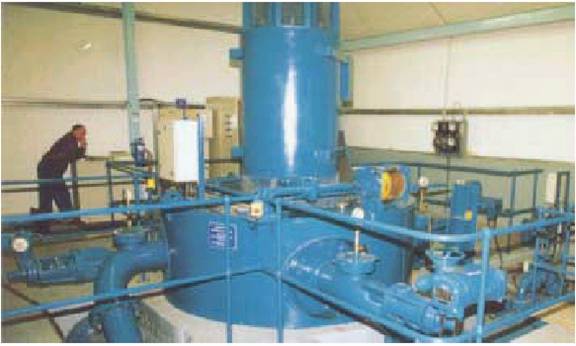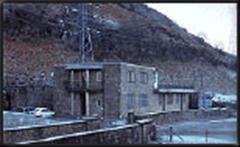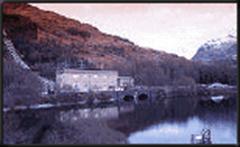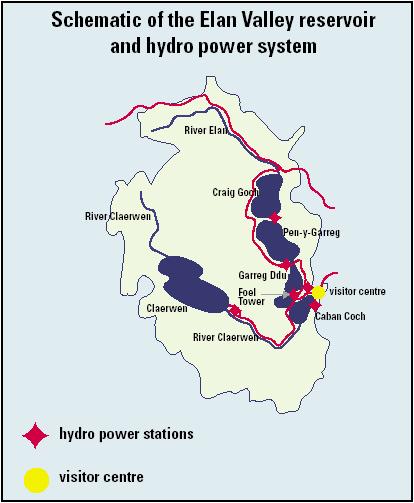[Hydro Case Studies]
Garbhaig Small Scale Hydro Scheme, Sloy / Awe Hydro Scheme, Elan Valley Hydro Scheme, The four dams involved, Calculations
![]()
Garbhaig Small Scale Hydro Scheme
This hydro scheme is located in the Slattadale Forrest, south of Loch Maree in Rosshire, Scotland. The project is owned and run by Garbhaig Hydro Power Company ltd, a Business Expansion Scheme (BES) company. This scheme was awarded an electricity purchase contract in July 1991; this was the procedure before the Scottish Renewable Obligation came into force (SRO-1). This meant that the power produced was sold at a premium price, making the scheme more economically viable.
A
2m weir was constructed at the mouth of the loch. Water flows through an underground
pipe through a head of 165m that powers a 1000kW Turbine. This drives a synchronous
generator of the same rating. Electricity is fed into the grid via a 415V -
33kV transformer.

A 1MW Pelton Turbine installed at the site
http://www.dti.gov.uk/
Consultation was carried out with a number of groups to consider the environmental
effects of building the scheme. These groups were; The Highland Regional Planning
Authorities, Scottish National Heritage, The Forestry Commission and Highland
River Purification Board. After discussion, planning permission was granted
provided that the final result had minimal environmental impact.
The original construction of the site cost £500,000 and then a further £600,000 for refubishment. The scheme benefits the public by supplying electricity and providing access to a site of natural beauty without causing any harm.
This scheme is the largest conventional hydro scheme in the UK. It is found within the region of Argyll, to the west of Loch Lomond. The station, which has an operating head of 277m, began operation in 1950.
The Sloy Dam holds the water, this structure is 56m high and 357m long. This dam had many affects on the water level: it was raised by 47m and the loch was extended by almost twice its length. This changed the ecosystem in the area and affected the plant and wildlife within this region.
Water
makes its way to the loch from north and south directions using a network of
tunnels and aqueducts. This serves to increase the catchment area of the scheme
and increase the water available for use in generation.
A tunnel 3km long carries water from Loch Sloy through Ben Vorlich to the valve
house above the power station. From here the water makes its way down the mountain
via four pipelines in to the station at Inveruglas Bay on the shores of Loch
Lomond.
Inside the power station there are four vertical shaft-generating sets, which altogether provide 152.5MW. There is emergency back up available from a 450kW Pelton wheel turbine.
This station is important not just due to its size but also because of its ability to react quickly to surges in demand. It can go from standing still - not generating, to full load in around 5 minutes.


Loch
Sloy Power Station
http://www.scottish-southern.co.uk/
, http://www.scottish-southern.co.uk/
This
hydro scheme is located in the Cambrian Mountains of mid Wales. The project
is owned and run by Hyder Industrial ltd, who are a subsidiary of Hyder plc
who specialise in small scale hydro plants.
The Elan and Claerwen river valleys comprise of five reservoirs and four dams
in total, all built in the period of the end of the nineteenth century and 1952.
Altogether, these five reservoirs hold a total of 199 million tonnes of water
and are the main supplier of water to Birmingham in England. The waters feed
the Elan River below the Caban Coch dam, from where it flows on to the river
Wye that is one of the most important Salmon Fisheries in Wales. The Caban Coch
was the only dam to have turbines installed during the initial construction
at the end of the nineteenth century.

The overall layout of the Elan Hydro Scheme,
http://www.dti.gov.uk/
Craig
Coch: 36.5m high, 480kW turbine, water leaving this turbine goes into the
upper end of Pen-y-Garreg reservoir.
Pen-y-Garreg: 37.5m high, 810 kW turbine, water leaving this turbine
goes to two places; Garreg Ddu and Caban Coch reservoirs.
Claermen: 56m high, 1680kW turbine (40% of generating capacity of valley),
the water returns to the river Claerwen and flows into the Caban Coch reservoir.
Caban Coch: Lowest dam of the whole scheme, 37m high, with two turbine
houses at the bottom containing; one containing a 150kW and the other a 800kW
turbine. Water leaving this goes to the river Elan.
Each turbine drives a synchronous generator of the same nominal rating as the turbine.
At the Foel Tower water is extracted to transmit to Birmingham at a constant rate via three 14m high tubes. A 300kW submersible turbine is installed to produce electricity when the head of water is between 7.5-13.5m.
In the winter, the reservoirs are full and water is in no short supply, this is the opposite of the situation in summer when the low levels mean appropriate levels have to be attained in the reservoirs. In winter any overspill can be released through the turbines to produce electricity.
Electricity is generated at the scheme at 415V then raised via a transformer to 11,000V for transmission.
90% of the area is designated as sites of specific scientific interest (SSSIs).
The scheme underwent many efforts not to affect this area. All cables and turbine
houses bar one are buried underground to minimise their visible effect on the
landscape, and also to minimise the disruption and disturbance of birds in the
area after meeting with the Royal Society for the protection of birds (RSPB).
The roads to the site have lead to the site being more easily accessible for
people, and the scheme has increased visitor numbers in the area.
The construction of the site cost £5.2 million
To see methodology for calculations click here
Garbhaig
Rated
Capacity: 1000kW
Annual consumption of electricity from a home in Scotland = 3880kWh/year (gas
heated)
= 10127kWh/year (electrical)
Assume capacity factor of 35%
Maximum Electricity Produced per annum (kWh) = 1000 * 8760
= 8760000 kWh
Electricity
Produced per annum (kWh) = 8760000 * 0.35
= 3066000 kWh
Number
of Homes = 3066000 / 3880
= 790 gas heated homes
= 3066000 / 10127
= 302 electrical heated homes
Sloy / Awe
Rated
Capacity: 152.5MW = 152500kW
Annual consumption of electricity from a home in Scotland = 3880kWh/year (gas
heated)
= 10127kWh/year (electrical)
Assume capacity factor of 35%
Maximum Electricity Produced per annum (kWh) = 152500 * 8760
= 1335900000 kWh
Electricity
Produced per annum (kWh) = 1335900000 * 0.35
= 467565000 kWh
Number
of Homes = 467565000 / 3880
= 120506 gas heated homes
=
467565000 / 10127
= 46170 electrical heated homes
Elan Valley
Rated
Capacity: 4220kW
Annual consumption of electricity from a home in Scotland = 3880kWh/year (gas
heated)
= 10127kWh/year (electrical)
Assume capacity factor of 35%
Maximum Electricity Produced per annum (kWh) = 4220 * 8760
= 36967200 kWh
Electricity
Produced per annum (kWh) = 36967200 * 0.35
= 12938520 kWh
Number
of Homes = 12938520 / 3880
= 3334 gas heated homes
=
12938520 / 10127
= 1277 electrical heated homes
![]()
Home, Beginners Guides, Case studies, Calculations, Hydro Power
![]()